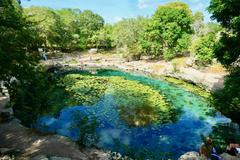Dzibilchaltún: Visiting Hours, Tickets, and Your Essential Guide to Mérida’s Historic Maya Site
Date: 14/06/2025
Introduction
Dzibilchaltún, located just 16 kilometers north of Mérida in the Yucatán Peninsula, stands as one of the region’s most significant and accessible Maya archaeological sites. Its name, meaning “the place where there is writing on flat stones,” speaks to the wealth of inscribed monuments scattered across the site. With roots going back as early as 500 BCE, Dzibilchaltún offers an unparalleled window into Maya history, urban planning, and living traditions. This detailed guide covers everything you need to know: visiting hours, ticketing information, how to get there, must-see attractions, community significance, and practical travel tips. Whether you are a history enthusiast, a casual visitor, or a culture seeker, Dzibilchaltún promises a rewarding and enriching experience (Audiala; The Brain Chamber; Yucatán Magazine).
Table of Contents
- Introduction
- Site Overview and Historical Background
- Urban Layout and Main Features
- Economic, Cultural, and Community Significance
- Archaeological Discovery and Ongoing Research
- Practical Visitor Information
- Nearby Attractions
- Frequently Asked Questions (FAQ)
- Visit Recommendations and Conclusion
- References
Site Overview and Historical Background
Dzibilchaltún is among the longest-inhabited Maya cities, with occupation spanning over 2,500 years, from at least 500 BCE through the Spanish colonial period (The Brain Chamber). At its peak during the Late Classic period (600–900 CE), the city may have supported a population of over 20,000 and contained more than 8,000 structures across nearly 20 square kilometers (Wonky Compass).
Its strategic location enabled Dzibilchaltún to thrive as a major economic and religious hub, linking the Gulf Coast with the Yucatán interior and facilitating trade in obsidian, jade, ceramics, and salt (Smithsonian Magazine). The site’s numerous stelae, altars, and ceremonial platforms highlight its cultural and political importance, while the evidence of continual rebuilding reflects a dynamic urban history.
Urban Layout and Main Features
Temple of the Seven Dolls (Templo de las Siete Muñecas)
The most famous structure at Dzibilchaltún, the Temple of the Seven Dolls, stands as a testament to Maya architectural and astronomical sophistication. Named for seven small clay figurines discovered beneath its floor, the temple is noted for its unique design—a square central chamber surrounded by a vaulted corridor, with entrances aligned to the cardinal directions (Popular Archaeology; Mayan Peninsula).
Each spring and autumn equinox, the rising sun shines directly through the temple’s eastern and western doors, creating a dramatic illumination that draws both scientists and spiritual observers (Mayan Peninsula). Archaeological research shows the temple underwent three major construction phases, with artifacts found in its fill attesting to centuries of ritual use.
Cenote Xlacah
Situated at the heart of Dzibilchaltún, Cenote Xlacah is one of the largest open cenotes in Yucatán, measuring about 200 feet in length and up to 144 feet in depth (Popular Archaeology). Historically, it served as both a crucial water source and a sacred site for offerings to Cha’ak, the Maya rain god. Archaeological finds from the cenote include pottery, tools, and human remains, offering invaluable insight into ancient rituals (Audiala).
Swimming in Cenote Xlacah may be permitted depending on current conservation rules, so always check at the entrance (Voyage Mexique).
Sacbeob (White Roads)
Dzibilchaltún features several ancient sacbeob, or white roads, built from limestone and rubble. The most prominent, Sacbe 1, stretches about 1.7 kilometers, connecting the temple to the central plaza and cenote. These causeways facilitated the movement of people and goods and were used for ceremonial processions (Mayan Peninsula).
Central Plaza and Colonial Chapel
The central plaza is surrounded by platforms and remnants of residential and ceremonial buildings. Notably, a 16th-century Spanish chapel stands atop a pre-Hispanic platform, symbolizing the region’s colonial transformation and the intersection of Maya and Spanish traditions (Voyage Mexique).
Museum of the Mayan People
The on-site museum displays stelae, ceramics, jewelry, and the original Seven Dolls, providing crucial context about Maya daily life, artistry, and belief systems (Voyage Mexique). The museum may occasionally be closed for renovations, so verify before your visit.
Economic, Cultural, and Community Significance
Dzibilchaltún was historically a major trading and religious center, with evidence of extensive economic networks and ritual activity (Smithsonian Magazine). Today, it remains a living emblem of Maya heritage, especially for the community of Chablekal, within whose ejido the site is located (Yucatán Magazine).
Local Maya guides and custodians play a vital role in sharing both archaeological knowledge and oral traditions. The spring and autumn equinoxes are celebrated with ceremonies and gatherings, reinforcing the site’s ongoing spiritual significance (Rutatrenmaya). Community stewardship and sustainable tourism efforts are key to balancing preservation with economic benefits (Yucatán Magazine; Global National Parks).
Archaeological Discovery and Ongoing Research
Explorers John Lloyd Stephens and Frederick Catherwood first documented Dzibilchaltún in the 19th century; systematic excavations began in the mid-20th century (The Brain Chamber). Modern technologies like LiDAR are revealing previously hidden structures and refining our understanding of the site’s scale and complexity.
Ongoing conservation projects aim to address threats from climate, tourism, and urban development. Recent upgrades, including a new visitor center, are designed to enrich the visitor experience and support educational programs (Wonky Compass).
Practical Visitor Information
Visiting Hours and Tickets
- Hours: Open daily, 8:00 AM–5:00 PM. Last entry is typically at 4:30 PM (Yucatán Magazine).
- Tickets: For 2025, general admission is 231 MXN (
$11.50 USD) for international visitors, 125 MXN ($6.25 USD) for Mexican nationals. Discounts available for students, seniors, and children (Bros Around The Globe). - Cenote Fee: Swimming may incur an extra charge (approx. 50 MXN), subject to current regulations.
Tickets are sold onsite; some authorized vendors may offer advance or bundled tour packages (History Hit).
Getting There
- By Car/Taxi: About 20–30 minutes north of Mérida. Taxis and ride-hailing apps like Uber are available; arrange your return in advance due to spotty cell coverage (Sailing Stone Travel).
- By Tour: Many Mérida operators offer excursions, often combined with visits to Progreso or other attractions.
- By Public Transport: Limited bus service from Mérida’s north terminal. Check schedules ahead.
Accessibility and Facilities
- Accessibility: Main visitor center and some paths are accessible, but much of the site features uneven terrain and stairs.
- Facilities: Restrooms, a café, souvenir shop, and shaded areas are available. On-site museum houses significant artifacts.
- Parking: Ample parking is provided.
Guided Tours
Local guides offer rich interpretation of Dzibilchaltún’s archaeology and cultural significance. Fees range from 200–400 MXN ($10–$20 USD); booking is recommended during peak times (The Mayan Ruins Website).
Safety and Etiquette
- Respect all posted signs; climbing some ruins is prohibited.
- Do not use sunscreen or insect repellent before swimming to protect the cenote ecosystem.
- Carry water, sun protection, and wear comfortable shoes.
- Support local businesses and guides for an authentic experience.
Nearby Attractions
- Mérida: Explore colonial architecture, museums, and vibrant markets.
- Progreso: Beach town with boardwalk and seafood restaurants.
- Other Maya Sites: Chichén Itzá, Uxmal, Mayapán, and the Puuc Route are all accessible for day trips (Travel to Merida).
Frequently Asked Questions (FAQ)
Q: What are Dzibilchaltún’s visiting hours?
A: Daily from 8:00 AM to 5:00 PM; last entry by 4:30 PM.
Q: How much are tickets?
A: 231 MXN for foreigners, 125 MXN for Mexican nationals; discounts available.
Q: Can I swim in Cenote Xlacah?
A: Yes, when permitted. Check conditions at the entrance.
Q: Are guided tours available?
A: Yes, with local Maya guides onsite or through tour companies.
Q: Is Dzibilchaltún accessible for people with disabilities?
A: The visitor center is accessible; much of the site has uneven terrain.
Q: How do I get there from Mérida?
A: By car, taxi, limited public bus, or organized tour.
Visit Recommendations and Conclusion
Dzibilchaltún is a must-visit for anyone interested in Maya history, culture, and the natural wonders of Yucatán. The site’s proximity to Mérida, combined with its rich archaeological remains, living traditions, and tranquil cenote, offer a multifaceted experience distinct from the busier Chichén Itzá or Uxmal. Visitors are encouraged to plan ahead, arrive early to avoid the heat and crowds, and take advantage of local guides for a deeper understanding.
By respecting site rules, supporting local custodians, and engaging with community-led tours, travelers contribute to sustainable tourism and the preservation of this extraordinary heritage. For current updates, downloadable guides, and interactive visitor tools, download the Audiala app and follow official sources.

References
- Dzibilchaltún Mayan Ruins: Visiting Hours, Tickets, and Historical Highlights Near Mérida, 2024, Audiala
- Dzibilchaltun Mayan Ruins Overview, 2024, The Brain Chamber
- Discover Dzibilchaltún: Visiting Hours, Tickets, and Must-See Mérida Historical Sites, 2024, Voyage Mexique
- Dzibilchaltún Archaeological Site Guide, 2025, Bros Around The Globe
- Dzibilchaltún Cultural and Community Perspectives, 2024, Yucatán Magazine
- Dzibilchaltún Archaeological and Cultural Insights, 2024, Rutatrenmaya
- Dzibilchaltún Historical Overview, 2024, History Hit
For further reading and updates, visit the INAH official website and check out the Audiala app for audio guides, real-time information, and exclusive content on Yucatán’s archaeological wonders.

